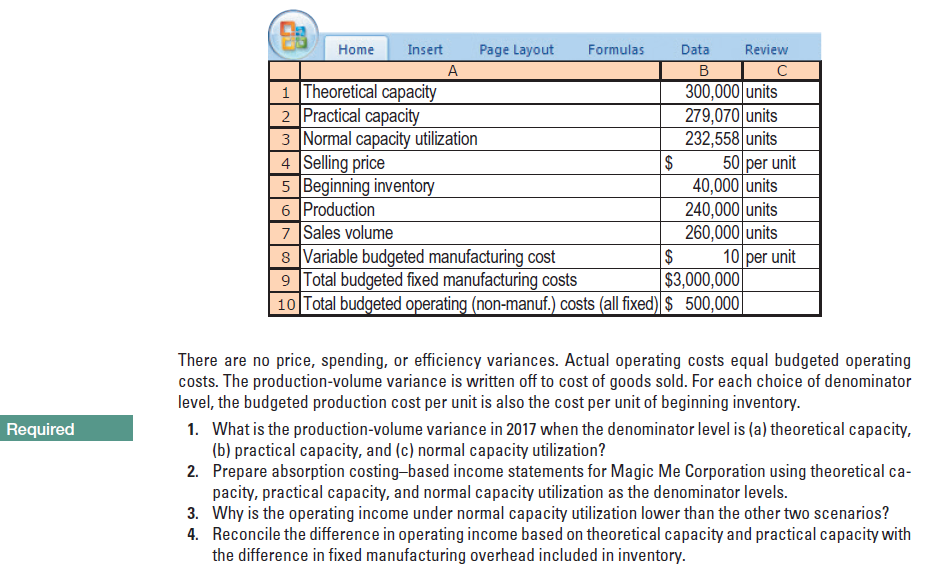Home Insert Page Layout Formulas Data Review A 1 Theoretical capacity 2 Practical capacity 3 Normal capacity utilization 4 Selling price 5 Beginning inventory 6 Production 7 Sales volume 8 Variable budgeted manufacturing cost 9 Total budgeted fixed manufacturing costs 10 Total budgeted operating (non-manuf.) costs (all fixed) $ 500,000 300,000 units 279,070 units 232,558 units 50 per unit 40,000 units 240,000 units 260,000 units 10 per unit $3,000,000 There are no price, spending, or efficiency variances. Actual operating costs equal budgeted operating costs. The production-volume variance is written off to cost of goods sold. For each choice of denominator level, the budgeted production cost per unit is also the cost per unit of beginning inventory. 1. What is the production-volume variance in 2017 when the denominator level is (a) theoretical capacity, (b) practical capacity, and (c) normal capacity utilization? 2. Prepare absorption costing-based income statements for Magic Me Corporation using theoretical ca- pacity, practical capacity, and normal capacity utilization as the denominator levels. 3. Why is the operating income under normal capacity utilization lower than the other two scenarios? 4. Reconcile the difference in operating income based on theoretical capacity and practical capacity with the difference in fixed manufacturing overhead included in inventory. Required
Home Insert Page Layout Formulas Data Review A 1 Theoretical capacity 2 Practical capacity 3 Normal capacity utilization 4 Selling price 5 Beginning inventory 6 Production 7 Sales volume 8 Variable budgeted manufacturing cost 9 Total budgeted fixed manufacturing costs 10 Total budgeted operating (non-manuf.) costs (all fixed) $ 500,000 300,000 units 279,070 units 232,558 units 50 per unit 40,000 units 240,000 units 260,000 units 10 per unit $3,000,000 There are no price, spending, or efficiency variances. Actual operating costs equal budgeted operating costs. The production-volume variance is written off to cost of goods sold. For each choice of denominator level, the budgeted production cost per unit is also the cost per unit of beginning inventory. 1. What is the production-volume variance in 2017 when the denominator level is (a) theoretical capacity, (b) practical capacity, and (c) normal capacity utilization? 2. Prepare absorption costing-based income statements for Magic Me Corporation using theoretical ca- pacity, practical capacity, and normal capacity utilization as the denominator levels. 3. Why is the operating income under normal capacity utilization lower than the other two scenarios? 4. Reconcile the difference in operating income based on theoretical capacity and practical capacity with the difference in fixed manufacturing overhead included in inventory. Required
Survey of Accounting (Accounting I)
8th Edition
ISBN:9781305961883
Author:Carl Warren
Publisher:Carl Warren
Chapter11: Cost-volume-profit Analysis
Section: Chapter Questions
Problem 11.16E
Related questions
Topic Video
Question
Denominator-level choices, changes in inventory levels, effect on operating income. Magic Me is a manufacturer of magic kits. It uses absorption costing based on

Transcribed Image Text:Home
Insert
Page Layout
Formulas
Data
Review
A
1 Theoretical capacity
2 Practical capacity
3 Normal capacity utilization
4 Selling price
5 Beginning inventory
6 Production
7 Sales volume
8 Variable budgeted manufacturing cost
9 Total budgeted fixed manufacturing costs
10 Total budgeted operating (non-manuf.) costs (all fixed) $ 500,000
300,000 units
279,070 units
232,558 units
50 per unit
40,000 units
240,000 units
260,000 units
10 per unit
$3,000,000
There are no price, spending, or efficiency variances. Actual operating costs equal budgeted operating
costs. The production-volume variance is written off to cost of goods sold. For each choice of denominator
level, the budgeted production cost per unit is also the cost per unit of beginning inventory.
1. What is the production-volume variance in 2017 when the denominator level is (a) theoretical capacity,
(b) practical capacity, and (c) normal capacity utilization?
2. Prepare absorption costing-based income statements for Magic Me Corporation using theoretical ca-
pacity, practical capacity, and normal capacity utilization as the denominator levels.
3. Why is the operating income under normal capacity utilization lower than the other two scenarios?
4. Reconcile the difference in operating income based on theoretical capacity and practical capacity with
the difference in fixed manufacturing overhead included in inventory.
Required
Expert Solution
This question has been solved!
Explore an expertly crafted, step-by-step solution for a thorough understanding of key concepts.
This is a popular solution!
Trending now
This is a popular solution!
Step by step
Solved in 4 steps with 7 images

Knowledge Booster
Learn more about
Need a deep-dive on the concept behind this application? Look no further. Learn more about this topic, accounting and related others by exploring similar questions and additional content below.Recommended textbooks for you

Survey of Accounting (Accounting I)
Accounting
ISBN:
9781305961883
Author:
Carl Warren
Publisher:
Cengage Learning

Survey of Accounting (Accounting I)
Accounting
ISBN:
9781305961883
Author:
Carl Warren
Publisher:
Cengage Learning